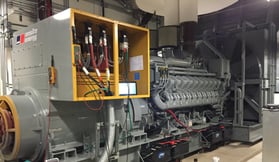
Fire is never fully preventable. However, by following the National Fire Protection Agency (NFPA) standards that guide the installation, performance and maintenance of power generation systems, you will minimize the potential of catastrophic losses.
NFPA 37, Fire Safety Requirements for Permanently Installed Engines, is the standard specifically concerned with ensuring that the power generator and its associated components are safely installed to minimize the chance of a fire – and to contain the spread should one occur. Unlike NFPA 110 and NFPA 70 (the National Electric Code), NFPA 37 does not address the big picture of performance or maintenance of the emergency system. Instead, NFPA 37 is squarely focused providing “minimum fire-safety requirements for the installation and operation” of permanently installed engines.
Generator Locations
Location and installation requirements are designed to prevent an engine fire from spreading to adjacent structures. NFPA 37 identifies four generator location categories:
- Dedicated rooms within a building
- Dedicated detached structures adjacent to a building
- Exposed on the roof of a structure
Installations
While NFPA 37 does not direct whether an engine within a building must be in a separate room, it does include requirements (Section 4.1.2) when there is a dedicated room. It also addresses installations on building roofs and outdoor installations, limiting the spacing of an enclosed generator set to a minimum of five feet from the engine housing to a combustible structure or wall.
There are two exceptions to the minimum distance requirement, opening the door for debate and discussion. We recommend following the five-foot separation requirement unless it’s absolutely necessary to seek an exception.
Fuel Supply
Chapter 5, Fuel Supply – Gaseous, outlines requirements for the distribution of fuel delivered in vapor form (natural gas, liquid propane vapor, and biogas) to an engine and required safety features within that distribution system, or system gas train. Section 5.4 additionally requires a manual shutoff valve to isolate the fuel supply.
Chapter 6, Fuel Supply – Liquid, is most often applied to diesel engines. It addresses engines with fuel in liquid form (fuel oil and diesel) and includes rules for fuel storage tank location and size as well as piping, valve and fitting requirements. There are exceptions spelled out in this chapter, as well. Check with your Authority Having Jurisdiction early in the project to guide the interpretation of the code and application of any exception you may seek.
Exhaust Systems
Chapter 8, Exhaust Systems, requires that the exhaust system is designed, constructed and installed in a way that does not present a safety hazard or fire hazard during normal operation.
The Last Word
For optimal performance and safety, it’s essential to stay up to code. To minimize fire hazards, be sure you’re up to code on NFPA 37.
If you have questions or need assistance for the safe installation of your on-site diesel or natural gas genset , we invite you to contact our team. Our experts are always ready to provide support for the design, installation, operation, testing and maintenance of your power generation system.
.png?width=159&height=72&name=Curtis%20Power%20Solutions%20(RGB).png)






